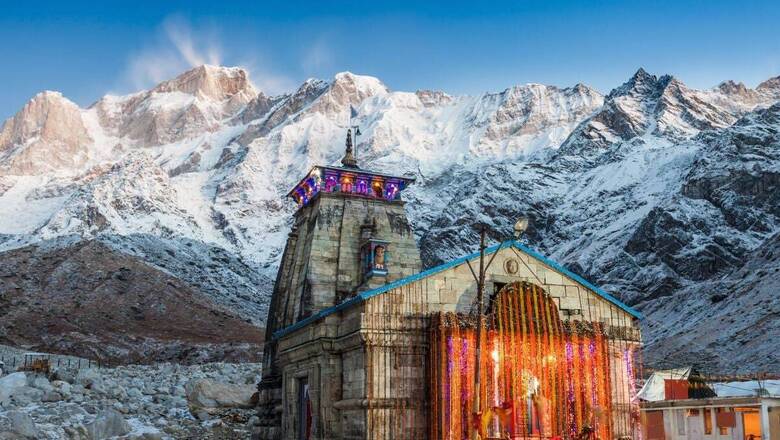
views
It has been a decade since the Kedarnath floods, a devastating calamity that took the lives of over 6,000 people and damaged properties worth millions of dollars. The subsequent years have not been kind to the region either, as the series of menacing flash floods and treacherous landslides have further compounded the challenges faced by the inhabitants of the mountainous terrain. These relentless natural calamities have tested the endurance of the people and the resilience of the land, leaving an indelible mark on the collective memory of the region.
Significant concerns persist regarding disaster management in Uttarakhand. Firstly, there is the issue of ongoing large-scale construction projects taking place in environmentally fragile regions of the state. This is accompanied by the problem of huge unregulated tourism in the state.
Secondly, the limited extent of disaster management in Uttarakhand raises apprehensions, as the focus seems to be primarily reactive rather than proactive, with actions primarily taken in response to past calamities. There is a need to stress on the importance of implementing sustainable practices, prioritising environmental protection, and striking a balance between tourism and land use.
Destruction by Extensive construction projects
The fragility of the mountains in Uttarakhand has been exacerbated by the presence of hydropower projects and rampant construction activities. Continuous operation of heavy machinery has further weakened the already vulnerable terrain. Strategy Paper on “Science & Technology intervention for post-disaster reconstruction efforts in Uttarakhand” by the Planning Commission highlighted that the June 2013 disaster was aggravated due to the unabated, unplanned and unregulated development in the region. Astonishingly, despite the tragic events of 2013, the sacred Kedarnath temple now finds itself surrounded by multi-storied buildings featuring flat concrete roofs, completely disregarding local traditions and the natural landscape. Rather than learning from past disasters, construction has taken place on the very debris left behind by the devastating Kedarnath disaster.
Similarly, the lessons from the 2021 Rishi Ganga flash flooding have gone unheeded. Despite concerns raised by experts suggesting a potential link between the Tapovan hydroelectric project and the disaster, the National Thermal Power Corporation (NTPC), responsible for the dam’s construction and the government vehemently denied any connection. The warnings issued are not recent revelations. For several decades, researchers and environmentalists have been consistently raising concerns about the ramifications of extensive development in Uttarakhand. Shockingly, even after warnings dating back to 1976 and cautionary notes about the unsuitability of Joshimath as a township due to the risk of sinking, the government proceeded to approve numerous hydroelectric power projects in the vicinity. This led to the influx of heavy equipment, blasting, and infrastructure development, further exacerbating the delicate balance of the region.
The building of roads without sufficient geological investigations is one of the other major issues in the area. Geological surveys are essential for comprehending the terrain, spotting potential dangers, and creating infrastructure that can withstand the forces of nature at work. Without these surveys, roads might be constructed on slopes that are prone to instability, landslides, or other geological dangers. This lack of foresight makes the infrastructure more vulnerable and endangered to both human life and the environment.
Unregulated Tourism in the state
Uncontrolled tourism has also significantly contributed to the exaggerated effects of disasters in the state. The government has frequently given infrastructure development a top priority in response to the rising demand for tourism to support the burgeoning sector. The Kedarnath floods of 2013 served as nothing less than a wake-up call. Despite numerous reports highlighting the significance of controlling tourist influx and implementing sustainable tourism practices to avoid recurring disasters, these measures have largely been unsuccessfully implemented, remaining only as theoretical concepts on paper.
Always a Knee-jerk Reaction
Despite being the first state in the country to establish a dedicated disaster management ministry, the previous instances of disaster management reveal a concerning pattern of authorities reacting to the aftermath and not being prepared in advance. While there have been advancements in communication channels, aimed at providing advance warnings to the public, doing solely this is not enough.
The Need
It was Kedarnath first and Joshimath next. Several other hilly regions are sitting on a bomb that can explode at any time. Over the past two decades, Uttarakhand has witnessed a distressing surge in the frequency and magnitude of disasters, leading to severe repercussions. It is crucial for the government and relevant authorities to prioritise the implementation of proper geological surveys, embankments, and water channels during infrastructure development in the Himalayas. Comprehensive laws and standards that strike a balance between tourism development, environmental protection, and sustainable land use are also necessary. They should include steps to safeguard delicate ecosystems, encourage responsible tourism, and make sure that infrastructure development is carried out in a way that reduces ecological risks and preserves the region’s distinctive natural heritage in the Himalayas.
In conclusion, the frequent occurrence of catastrophes like the Chamoli disaster and the Kedarnath floods serves as an urgent reminder of the need for aggressive action in Uttarakhand. The state must not only draw lessons from the past but also address the underlying causes of these catastrophes. Uttarakhand can only effectively handle disaster-related difficulties it faces and provide a sustainable and safe environment for future generations through proactive and coordinated efforts.
Mahek Nankani is Lead, Growth & Partnerships at The Educational Initiatives. The views expressed in this article are those of the author and do not represent the stand of this publication.


















Comments
0 comment